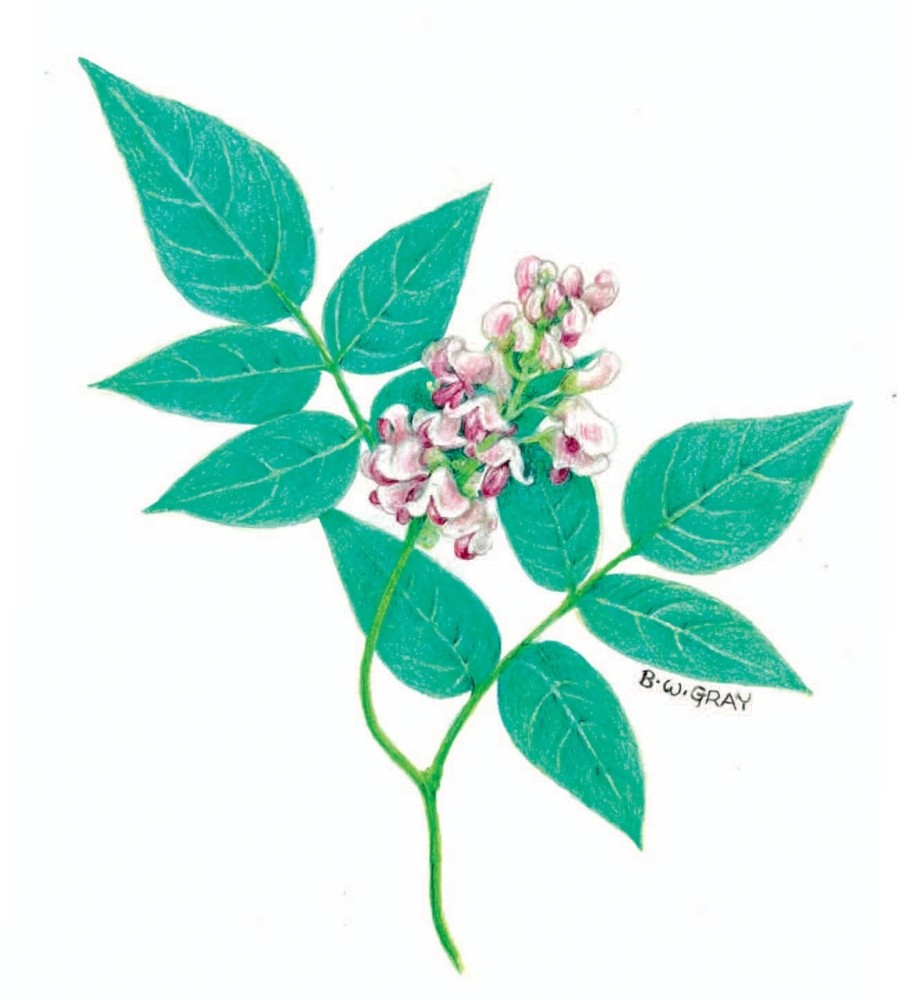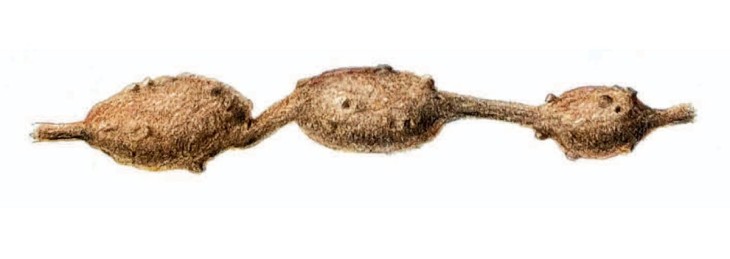(If You Know How and Where to Look)
Groundnut (Apios americana), an herbaceous, perennial member of the pea family (Fabaceae), is native to most of the eastern United States and adjacent areas of Canada. The aboveground part of the plant is a vine, with alternate, beanlike compound leaves, each composed of five to seven leaflets. The vines rarely get more than 5 feet off the ground, twining counterclockwise around any available support (note the lack of tendrils). In midsummer, groundnut vines often (but not always) develop clusters of fragrant, pink-to-brown blossoms, each with a bilaterally symmetrical “wing and keel” structure characteristic of their clan. The flowers are eventually followed by slender pods about 2 inches long, which, when fully brown and dry, often split open into a corkscrew shape, releasing brown, beanlike seeds.
From an alimentary standpoint, however, the most important part of this species lies 2 to 3 inches below the ground: its tubers, which range from the size of a marble to a golf ball, and sometimes even bigger. They appear as swellings on slender, horizontally growing roots, spaced 2 to 3 inches apart. Groundnut tubers have a long heritage as an important source of food for indigenous people; one of the common names for the species, hopniss, is of Lenape tribal origin. There is some correlation between the presence of groundnut vines and the location of historic indigenous encampments. While part of the reason might be that people set up camp where the plants already grew, it is very likely that tribal peoples shared groundnut seeds and tubers through trade, and new populations of the plants became established.
Groundnut tubers played a crucial role in the original European settlement of North America. Although you may have been taught otherwise in grammar school, it was these tubers, not corn, that kept the Pilgrims alive during the harsh winter of 1620–21, their first in the New World. In fact, groundnut tubers – high in starch and protein – were so important to the early colonists that many communities passed ordinances forbidding indigenous people from harvesting the plants within colonial settlements.
Groundnut thrives in partial to full sunlight in damp, sandy soil such as that found in river floodplains. The tubers are harvestable any time the ground isn’t frozen, although during the colder months, locating the beige-colored dead vines requires some skill. A case in point: during a winter when the ground was bare and not completely frozen, I noticed some familiar-looking dried vines on a trail along a river. I followed a vine to where it had emerged from the ground, dug a test hole and, sure enough, came up with a groundnut tuber. I quickly dug up a dozen more and had them with my breakfast that morning.
Because the tubers grow close to the surface, you can often harvest them using a hand trowel. Identify the spot where the vine emerges from the ground, and then follow it underground, taking care to avoid severing the tuber-bearing root. While it is unlikely you’ll find all the tubers, it is a good practice to leave some behind after harvesting to help ensure the species’ continued presence at that location.
Groundnut tubers will keep in the refrigerator for at least a month, wrapped in slightly moistened paper towels, or you can freeze them. A tasty way to prepare groundnuts is simply to slice them thinly crosswise (no need to peel them) and fry them in vegetable oil in a skillet until golden, then dry them with a paper towel, lightly salt them, and serve them promptly. If you wait too long, the chips lose much of their crispness and flavor. Groundnut tubers can also be boiled or baked like potatoes.
There are two important caveats. First, before digging, it is wise to check the area for the presence of poison ivy, as touching its roots can be at least as strongly rash-producing as the aboveground part of that species. Second, and even more important: there are reported instances of people becoming sickened from eating groundnut tubers, even after having consumed them previously with no adverse effect. Wild edibles expert Sam Thayer urges caution when eating this species, suggesting thorough cooking (for several hours, as in a stew).



